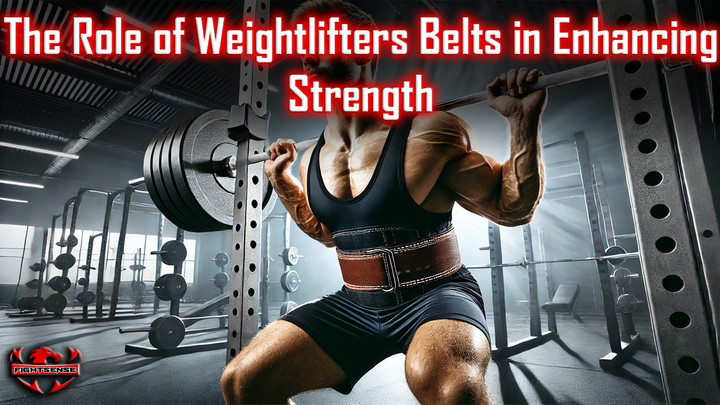The Role of Weightlifters Belts in Enhancing Strength
20th Mar 2025
Weightlifters Belts are more than just gym gear—they’re essential tools for boosting strength, enhancing stability, and protecting the body during heavy lifts.
Whether you’re a beginner learning proper form or an experienced athlete pushing for new records, understanding the value of weightlifters belts can take your training to the next level.
Key Highlights
-
Provides core stability by increasing intra-abdominal pressure.
-
Maintains spine neutrality, protecting it and aiding in heavier lifts.
-
Promotes proper form, improving technique and preventing injury.
-
Ideal for maximum lifts, not for smaller exercises.
Belts for weightlifters: a vital component of lifting gear
A weightlifters belt is an essential tool for everyone who take weightlifting seriously since it greatly helps to protect the body during large lifts. Whether you're deadlifts, squats, or overhead presses, the weightlifters belt provides necessary support that can make all the difference between a good lift and an injury.
But why do weightlifters use belts and what exactly does a weightlifters belt do? These belts are designed to provide greater stability and support to the lower back and core muscles, allowing athletes to lift heavier weights more safely.
By increasing intra-abdominal pressure, the belt helps maintain proper posture during challenging movements and improves overall body alignment. This added support reduces the risk of injury and minimizes strain on the spine.
Why Do Weightlifters Wear Belts?
Beginners or those new to weightlifting often wonder, "Why do weightlifters wear belts?" Weightlifters primarily wear belts to enhance their performance and prevent injuries. In order to improve their performance and avoid injuries, weightlifters mostly wear belts.
Using a weightlifter's belt mostly benefits from the raised intra-abdominal pressure it produces when tightly attached. As a support for the spine, this pressure lets lifters keep a neutral spine posture all during their lifts.
Key Features and Functionality of Weightlifters Belt
-
Material: Typically made of leather or nylon, offering flexibility and strength for support.
-
Width: Most belts are 4 inches (ca. 10 cm) wide, providing lower back and abdominal support without restricting movement.
-
Core Activation: Raises intra-abdominal pressure to efficiently engage core muscles, providing a solid lifting foundation.
-
Spinal Support: Enhances posture and helps protect the spine during heavy lifts.
-
Improved Technique: Promotes better form and alignment, improving overall lifting technique.
The advantages of wearing weightlifting belt
Wearing a weightlifters belt offers many advantages, particularly for high-intensity movements like deadlifts or squats. Among the main advantages are:
-
Core Resilience: A weightlifter's belt improves core engagement by giving additional support, so enabling improved force transmission and more efficient lifting.
-
Vertebral Safeguarding: Add intra-abdominal pressure to help keep the spine in a neutral position during large lifts and lower the danger of spinal compression.
-
Optimization: Using a weightlifter's belt increases stability and lowers the possibility of damage, thereby enabling you to raise larger weights more safely.
-
Enhanced Technique: The belt's increased support helps to correct form and posture, therefore lowering the danger of negative habits starting during training.
-
Mitigation: Particularly during compound exercises like squats and deadlifts, which apply great pressure on the spine, the weightlifters belt helps guard the lower back from too much strain.
Maximizing the Weightlifters Belt Effect
Although a weightlifters belt has several advantages, proper use is essential to maximize its effectiveness. The belt should be snug but not overly restrictive. When worn correctly, it should feel firm around your midsection, supporting your core while still allowing normal breathing and movement.
To get the most out of a weightlifters belt, be sure to:
-
Tighten it correctly: Fasten the belt tightly around your waist such that it creates intra-abdominal pressure but not so tight as to prevent your breathing.
-
Engage your core: To maximize the impact of the belt, deliberately tense your abdominal muscles when lifting. This stabilizes the spine and helps produce the highest intra-abdominal pressure, therefore reducing damage.
-
Use it just for big lifts; it's advisable to wear the weightlifters belt during maximal or almost maximum exercises. For smaller lifts, concentrate on developing your core free from the belt.
Shop Now !
Conclusion
Ultimately, everyone who wishes to safely and efficiently raise their lifting ability will find a weightlifters belt to be absolutely essential. Weightlifters belts are absolutely essential for boosting performance during large lifts since they increase core stability, shield the spine, and promote general technique.
Investing in a premium weightlifting belt will significantly affect your training outcomes regardless of your level of experience as an athlete.
Disclaimer: Always consult a certified fitness expert or healthcare provider before starting a new workout program or using any lifting equipment—especially if you have pre-existing injuries, medical concerns, or are unsure about proper technique.

